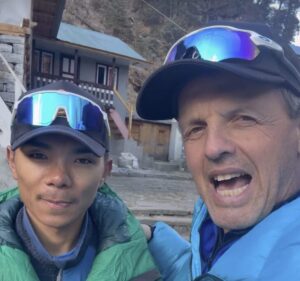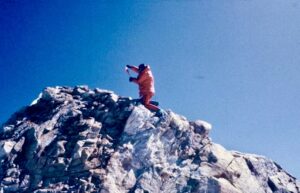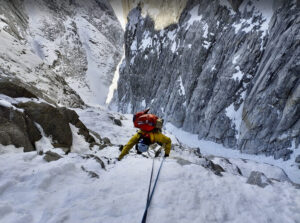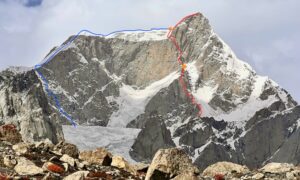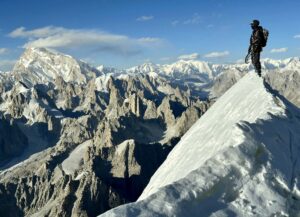Gasherbrum I, or Hidden Peak, lies in the Karakoram on the border between Pakistan and China. It’s 8,080m high and has a prominence of 2,155m. This eleventh-highest mountain in the world was first ascended on July 5, 1958 via the north side by Americans Pete Schoening and Andy Kauffman, members of an eight-man team led by Nick Clinch.
In 2011, Canadian Louis Rousseau, Austrian Gerfried Goschl, and Spaniard Alex Txikon spent more than 50 days on the first winter attempt on Gasherbrum I. The approach from Askole to Base Camp marked the first time that anyone had done that trek in winter. It took them a week.
On Jan. 31, 2011, they reached Base Camp at 5,100m. According to Rousseau and Goschl’s report for the American Alpine Journal, the temperatures at night ranged from minus -20˚C to -30˚C.

Gasherbrum I, aka Hidden Peak. Photo: Ferran Latorre
Two days later, on Feb. 2, Denis Urubko, Simone Moro, and Cory Richards summited Gasherbrum II without bottled oxygen or porters. Thus, they became the first to climb a Pakistani 8,000m peak. They had a close call on the way down when an avalanche buried them, but they freed themselves and descended safely. Cory Richards documented that climb in the film, Cold.
South Face winter attempt
The other team’s success buoyed the spirits of Goschl, Txikon, and Rousseau. They decided to attempt the first winter ascent of Gasherbrum I along a partially new route.
They planned to follow the couloir and ridge close to the right edge of the triangular rock face that forms the left side of the west-southwest face of 7,069m Gasherbrum South. At the top of the triangle at about 6,800m, they would cross the upper section of the southeast ridge. Here, at 7,500m, they’d join the 1958 American route.

Number 6 marks the 2011 winter attempt route. Photo: Louis Rousseau for the American Alpine Journal
On Feb. 4, 2011, the trio started up. But from that day until the first days of March, the weather was poor, and clouds covered the sky. They worked hard up a steep slope of rotten rock and hard ice to establish a camp at 6,300m.
On March 9, they reached 6,650m after climbing 1,500m of new ground. But the final 200m of a 70˚ ice slope proved unclimbable for them. They had to turn around.
They had a second chance a few days later when their weather forecaster, Karl Gabl, announced a fresh weather window. This time, the three decided to make an alpine-style attempt of the standard route up the Japanese Couloir.
They surmounted the couloir at 7,050m. Here, they spent the night. The next morning, 80kph winds forced them to retreat. They reached Base Camp on March 15.
On July 13 of that same year, Goschl climbed Gasherbrum I with several others, despite bad snow conditions. After that successful summer expedition, he decided to give winter another try and returned to GI the next year.

Gerfried Goschl at 6,200m on Hidden Peak, during his first winter attempt in 2011. Photo: Gerfriedgoeschl.at
Winter 2012
“Since I now know the mountain very well from both sides…I want to make the first winter ascent of Hidden Peak, climb a new route to the summit, and complete the first traverse of an 8,000er peak in winter,” he stated boldly.
Goschl planned to finish the South Face route to the summit, then descend the normal way on the opposite side with an international team. But in February 2012, the headwall — a steep wall on the glacier plateau over which the international expedition’s new route ran — was accessible only with difficulty.
He and his partners made a first attempt but failed to advance beyond the headwall. But the forecast promised another spell of good weather around March 8-9.

Janusz Golab enters the Japanese Couloir on Gasherbrum I. Photo: Janusz Golab
Goeschl’s team shared Base Camp with a Polish group, led by Artur Hajzer, which also wanted to make the first winter ascent of Hidden Peak. The Poles planned to follow the normal route and summit on March 9.
Goschl and two partners, Cedric Hahlen of Switzerland and Nisar Hussain Sadpara of Pakistan reached Camp 2 at around 7,000m on March 7. They planned to summit in the early afternoon of March 8.
Tragedy strikes
However, on March 8, Goschl, Hahlen, and Sadpara managed to reach just 7,630m after 7.5 hours. Another 450m remained to the summit. Around 10:30 am, Goschl, Hahlen, and Sadpara made a satellite phone call. Shortly after that, they lost touch.
From Base Camp, Alex Txikon, a member of the international team, last spotted the three climbers about 250m below the summit. That was the last known location of Goschl and his small team. During that whole time, both sides of the mountain were enveloped in strong winds and storms.

Cedric Hahlen, Gerfried Goschl, and Nisar Sadpara. Photo: Polski Alpinizm i Himalaizm
Adam Bielecki and Janusz Golab from the Polish team finally summited in almost no wind and clear skies via the normal route on March 9, at 8.30 am. By the time they returned to Camp 3, around the time that Goschl made their last satphone call, the weather had already begun to change. By 5 pm that day, the weather had deteriorated, with fog and a very strong wind.
“We succeeded but sadly our friends…just ran out of time,” recalled Hajzer afterward. The strong winds may have blown them off the mountain. On March 10, a multiday rescue operation began, but neither a helicopter nor searchers on the ground could find any trace of the missing climbers.
Artur Hajzer, who failed to summit with Golab and Bielecki, returned the following summer to attempt Gasherbrum I again. He died on July 7, 2013, after a fall in the Japanese Couloir.

Artur Hajzer, Gasherbrum I. Photo: Agnieszka Bielecka

